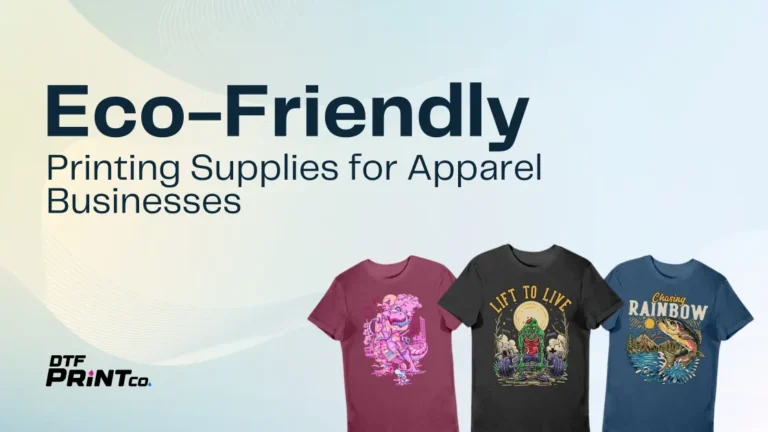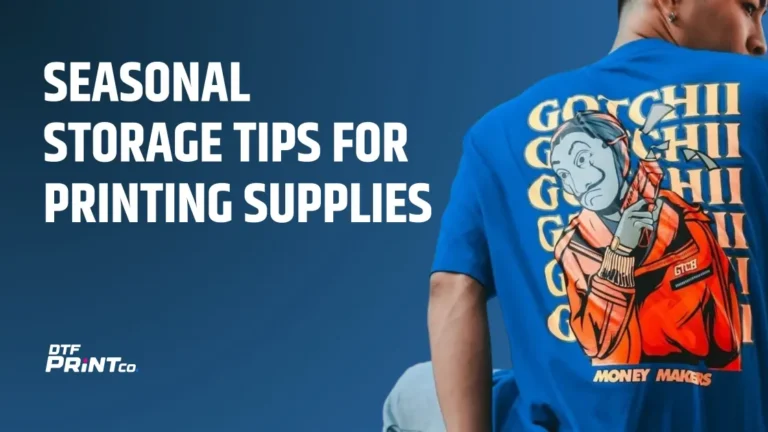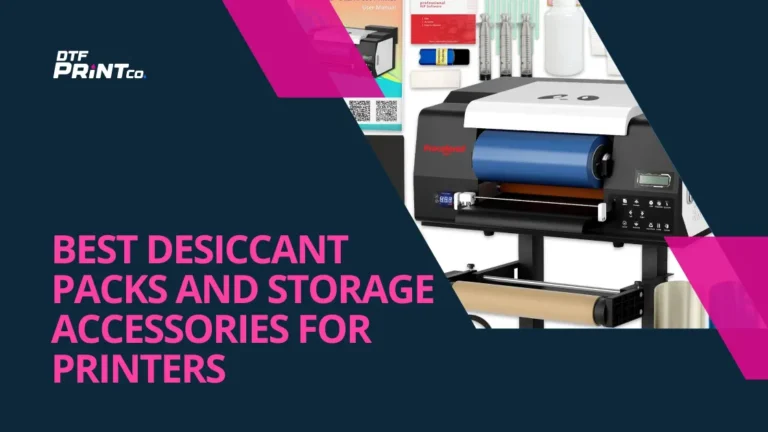
Eco-Friendly Printing Supplies for Apparel Businesses
Eco-friendly printing supplies help apparel businesses cut waste, lower costs, and protect the planet. Switch to water-based inks, organic fabrics, and energy-efficient equipment to make

To price custom DTF-printed garments profitably, add up your total production costs—blank garment, DTF transfer, labor, and overhead—then apply a markup that secures your target profit margin (typically 30–60%). Regularly review costs, adjust for bulk orders, and track actual margins to stay competitive and sustainable.
Pricing custom DTF-printed garments can be tricky. Many printers undercharge, forgetting hidden costs like film waste, setup time, or packaging—only to find profits vanish. Others overprice and lose customers to cheaper competitors. If you’ve ever felt unsure about what to charge for your shirts, hoodies, or tote bags, you’re not alone.
This guide simplifies the process. We’ll break down every cost that goes into a DTF-printed garment, show you proven formulas to set fair prices, and share real-world examples to help you protect your profit—without scaring away buyers. Let’s walk through each step with clear math and easy-to-follow strategies.
Start with the blank. Prices vary by fabric, brand, and style. Cotton basics cost less than heavyweight tees or premium blends. Hoodies, long sleeves, and specialty cuts add dollars fast. Don’t forget size upcharges for XXL and above, plus shipping into your shop. If you buy from multiple suppliers, log average landed cost so you’re not surprised later. Keep a living spreadsheet and review it monthly.
DTF costs are more than a single “transfer” price. Include:
If you outsource transfers, your unit cost is your vendor price plus shipping and any rush fees. If you produce in-house, estimate consumption rates and spread them over the usable print area. Keep notes on common sizes (left chest, full front) so your quotes stay consistent.
Labor includes everything from receiving blanks to final fold. Track hands-on minutes for setup, pressing, curing, and finishing. Multiply by an hourly labor rate that includes payroll burdens and training time. Overhead covers the shop’s ongoing expenses: utilities, rent, software, insurance, and equipment depreciation. Spread these fixed costs across jobs using an overhead absorption rate (e.g., overhead per press-hour). A simple approach: estimate total monthly overhead and divide by the total press-hours worked that month to get an overhead per hour you can allocate to each job. For general pricing strategy fundamentals, the U.S. Small Business Administration has a helpful primer on cost and pricing that’s worth bookmarking: SBA pricing strategies.
Add costs for poly mailers, tags, size stickers, and inserts. If you ship, include postage, packaging, and time spent printing labels. Online payments include processing fees that can take a noticeable bite out of revenue. Plan for returns and reprints. Build a small buffer to cover defects without wiping out your margin on the entire order.
This is the most common method because it’s fast and predictable. Formula:
If your total cost per garment is $10 and you use a 1.7× markup, the price is $17. The benefit is simplicity and consistency across SKUs. The downside is you might leave money on the table for premium jobs or underprice when your market can bear more. When choosing a markup, consider your brand positioning and competitive landscape.
Margin and markup are not the same. Margin focuses on profit as a percentage of the final price. Formula:
If cost is $10 and you want a 50% margin, the price becomes $20. Margin is easier to monitor on financial statements and aligns with common ecommerce reporting. To brush up on the difference (which trips people up), see markup vs. margin on Investopedia. For apparel, a 30–60% margin is typical depending on complexity, brand strength, and service speed.
Break-even is the price at which your revenue covers all costs but earns no profit. It’s your absolute floor. You calculate unit break-even by dividing your total job cost by the number of units. You can also view break-even through an hourly lens: the minimum billable rate that covers labor and overhead per press-hour. Break-even keeps you from accepting money-losing jobs when you feel pressured to say yes.
DTF shines for short to medium runs, but your fixed setup time per job makes tiered pricing smart:
The key is protecting margin at low volume while staying competitive on larger orders. You can also bundle add-ons (neck tag prints, sleeve hits) and offer upsells like premium blanks or specialty finishes.
Price should reflect the channel and customer segment. Retail pricing on your website might differ from wholesale for boutiques or corporate buyers. Event or pop-up pricing can support on-site convenience and limited-edition drops. For premium pricing, emphasize high-quality blanks, color accuracy, eco inks, or white-glove service. This positions your shop as a value leader, not the cheapest option. For context on healthy ecommerce margins, see Shopify’s overview of profit margin concepts and targets.
Understanding what others charge helps you position your business strategically. Start by exploring local print shops, online marketplaces, and small apparel brands. Compare prices for similar garment types, print sizes, and turnaround times. This gives you a benchmark range. Avoid the “race to the bottom” trap—cheap pricing without profit is unsustainable. Instead, identify what differentiates your service: speed, print quality, design assistance, or eco-friendly inks. Use those strengths to justify your pricing.
Gather feedback from existing clients to learn what they value most. Many are willing to pay more for consistent results and reliability. Tools like Google Shopping and Etsy search help monitor real-world prices. Also check industry communities and forums like T-Shirt Forums for insights into current market rates. Combine these data points to find a sweet spot that balances affordability and profitability.
Hidden costs often separate profitable shops from struggling ones. Include waste from misprints, returns, and damaged transfers. Factor in lost time when a press malfunctions or orders get delayed. Build a contingency percentage—commonly 5–10% of total cost—to protect your margin. Track patterns in spoilage so you can improve efficiency rather than simply padding prices.
DTF supplies—inks, film, and blanks—can change price monthly due to market demand or import costs. Avoid surprises by reviewing your supplier invoices regularly. If you notice a steady increase, adjust your price chart or add a clause for cost-based revisions on large contracts. For example, note that “prices are subject to change if material costs rise more than 5%.” This ensures transparency while protecting your business.
You can stay informed by checking supplier updates or resources like Printing United Alliance, which publishes cost trend insights. Keeping customers informed builds trust even when you must raise prices.
Fast turnarounds and short runs consume disproportionate setup time. Implement a rush fee (e.g., 20–30%) for same-day or next-day orders. Likewise, add a minimum order fee to prevent losses on single-shirt jobs. A clear pricing policy avoids awkward negotiations. Customers respect structure, especially if your rush jobs deliver reliably.
Seasonal promotions can attract volume during slow months but must not erode your profit margin. Structure discounts smartly—offer free shipping or bundle deals instead of straight price cuts. For example, “Buy 20 shirts, get 2 free” keeps your perceived value high while maintaining profitability. Plan promotions around inventory cycles or new product launches. Data from Google Trends can reveal when interest in custom apparel spikes (e.g., holidays, sports seasons), helping you time offers for maximum effect.
To make the formulas concrete, here are three real-world style examples:
| Case | Garment Type | Total Cost (Blank + Print + Overhead) | Target Margin | Price per Unit | Notes |
| 1 | Basic T-shirt (small logo) | $9.00 | 40% | $15.00 | Entry-level item, minimal labor |
| 2 | Premium Hoodie (full front) | $18.00 | 50% | $36.00 | High-quality blank, larger print area |
| 3 | Bulk Order (100 T-shirts) | $7.50 | 35% | $11.50 | Lower unit margin but large volume |
These numbers illustrate how cost structure changes your pricing decisions. The hoodie carries higher risk (material and labor) and earns a larger margin, while the bulk order sacrifices some percentage profit for steady cash flow. Always analyze total job profit rather than just per-piece markup.
Keep a pricing calculator spreadsheet to test how margin changes affect the final price. For free templates, explore resources on Printavo or InkSoft, which offer DTF-focused pricing tools.
Profitability isn’t static. Track your cost of goods sold (COGS) monthly and compare it against your target margins. If you notice margins shrinking, revisit your consumable usage or adjust pricing tiers. Use sales data to find your most profitable garment types and designs, and focus marketing on those.
Testing helps refine your pricing. Try small experiments: increase prices by 5% on one product line for two months and measure if sales drop. Most customers barely notice small adjustments if your service and quality remain strong.
Use analytics from your ecommerce platform or POS to watch conversion rates. If a product gets many views but few sales, test a slightly lower price or reposition it as a premium option with added value (like free personalization).
Finally, revisit pricing quarterly or whenever material costs shift. Staying proactive ensures you never operate below your profit threshold. For advanced tips, read Shopify’s guide on pricing optimization to align strategy with customer behavior and competitive positioning.
Fair, transparent pricing builds long-term trust and loyalty. Many customers appreciate understanding why a custom DTF print costs what it does—especially when you can explain how premium materials, durable prints, and reliable service justify the price. Clear communication prevents misunderstandings and supports your brand’s professionalism.
When customers question your rates, educate rather than defend. Briefly outline your cost structure: quality blanks, non-toxic inks, local labor, and small-batch flexibility. You can even create a short “How Our Pricing Works” page on your website to explain the process in simple terms. Transparency like this strengthens credibility.
It’s okay to turn down unprofitable jobs. Say “no” confidently when a client insists on paying below cost. Taking bad orders drains time and energy you could devote to better clients. Maintaining pricing integrity keeps your business sustainable. Offer alternatives instead—simpler designs, longer turnaround times, or smaller print areas—to help price-sensitive customers without undermining your model.
Discounts should be strategic, not reactive. Avoid offering random markdowns just to close a sale. Instead, set up structured discount programs for loyal customers or large-volume clients. This approach rewards repeat business while keeping your margins healthy.
Consistency across all customers also matters. Avoid charging wildly different prices for similar jobs unless clear factors—like urgency or garment quality—justify it. Consistency reflects fairness and professionalism, two key pillars for business reputation.
Reliable tools save hours of manual work and improve pricing accuracy. Start with a pricing calculator spreadsheet that lists every variable: garment cost, ink cost, film, labor time, and overhead. Use formulas to update automatically when any cost changes. This simple document becomes the backbone of your pricing system.
You can create one yourself in Excel or Google Sheets, or try free online calculators from reputable printing software providers like Printavo, InkSoft, or DTF Station. These platforms often include templates that help estimate print cost per square inch, a crucial metric for scalable pricing.
Other useful resources include:
Keeping a folder of reference materials—pricing spreadsheets, supplier invoices, margin reports—makes quarterly reviews fast. Treat your pricing like an evolving system, not a one-time setup.
Profitable pricing for DTF-printed garments comes down to one thing: knowing your true costs and charging confidently above them. Every blank shirt, transfer sheet, and minute of labor adds up. By including overhead, packaging, and payment fees, you capture the complete picture of production.
Combine that knowledge with clear markup or margin formulas, and you’ll avoid the guesswork that sabotages so many print shops. The most successful apparel businesses review their prices every few months, adapting to material costs and market demand.
Remember, pricing isn’t about being the cheapest—it’s about delivering value that justifies your rate. Your skill, reliability, and attention to detail are worth charging for. Take time this week to update your cost sheet, test a few pricing tiers, and watch your profits stabilize. Your business—and your peace of mind—will thank you.
What is a reasonable profit margin on DTF-printed garments?
Most shops target 30–60%, depending on complexity, overhead, and market. Higher margins are typical for premium items or small runs.
Should I charge differently for small versus large orders?
Yes. Small orders should carry higher per-piece prices to offset setup time, while bulk orders can get discounts for efficiency.
How often should I revisit my pricing?
Recalculate at least quarterly, or anytime material or labor costs change noticeably.
Is it okay to raise prices mid-year if costs go up?
Absolutely. Communicate changes early and explain the reason clearly—customers respect transparency.
How do I handle custom requests or design changes from clients?
Charge a design or revision fee. It protects your time and ensures every project remains profitable.

Eco-friendly printing supplies help apparel businesses cut waste, lower costs, and protect the planet. Switch to water-based inks, organic fabrics, and energy-efficient equipment to make

To store printing supplies safely year-round, keep ink and toner in a cool, dry place, protect paper from humidity, and adjust storage for seasonal temperature

Keep your printer safe from moisture by using high-quality desiccant packs and airtight storage accessories. These prevent humidity damage, protect print quality, and extend your

2023 - 2024 © ALL RIGHTS RESERVED